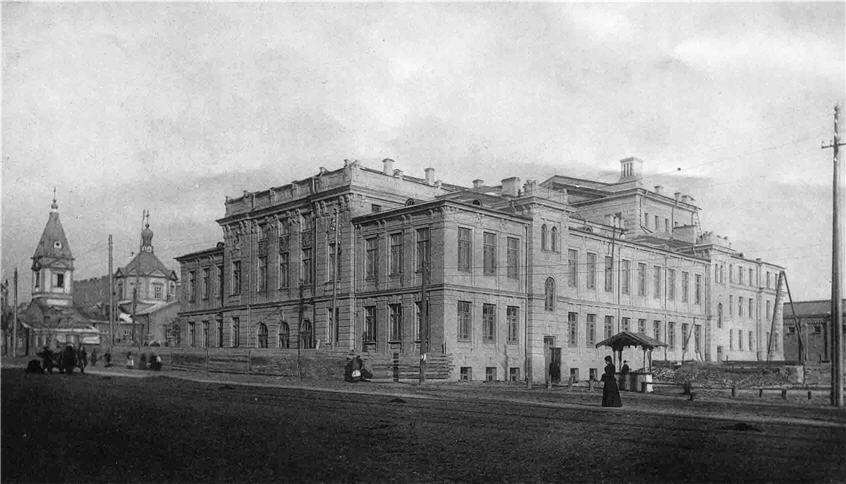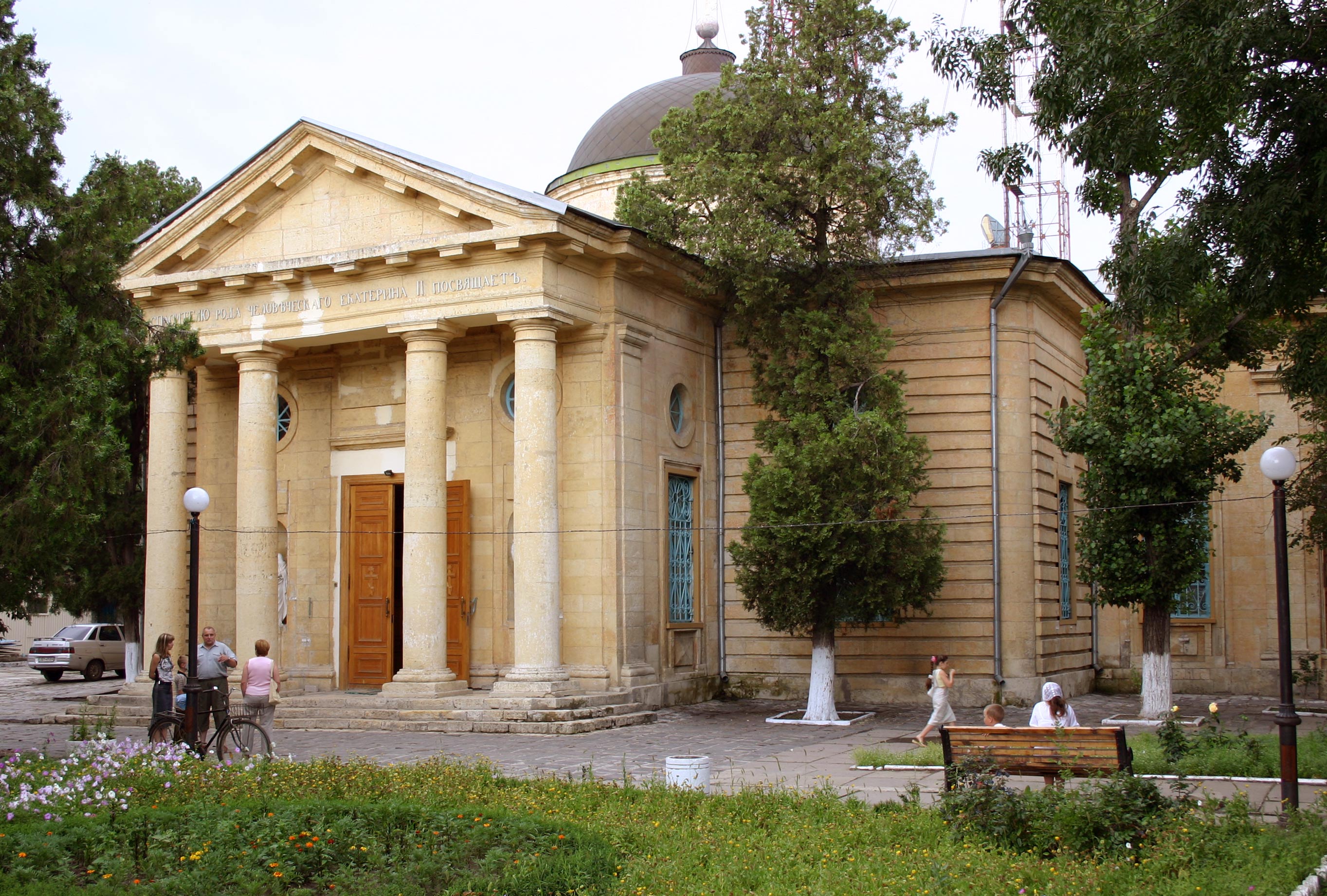|
Donetsk–Krivoy Rog Soviet Republic
The Donetsk–Krivoy Rog Soviet Republic or Donetsk–Kryvyi Rih Soviet Republic (russian: Донецко-Криворожская советская республика , translit = Donetsko-Krivorozhskaya sovyetskaya respublika, ) was a self-declared Soviet republic of the Russian SFSR proclaimed on 12 February 1918. It was founded three days after the government of the Ukrainian People's Republic (UPR) signed its Treaty of Brest-Litovsk with the Central Powers, which recognised the borders of the UPR. Lenin did not support the creation of the entity and neither did Sverdlov. Some other Bolsheviks like Elena Stasova, however, sent a telegraph of best wishes. The Donetsk–Krivoy Rog Soviet Republic claimed the territories south of the neighbouring Ukrainian People's Republic, including the Donbas, Kharkiv, Yekaterinoslav, and part of the Kherson Governorates. In the beginning, the republic's capital was the city of Kharkiv, but later with the retreat of the Red Guard it m ... [...More Info...] [...Related Items...] OR: [Wikipedia] [Google] [Baidu] |
Ukrainian Soviet Encyclopedia
The ''Ukrainian Soviet Encyclopedia'' ( uk, Українська радянська енциклопедія, ''Ukrayinska radyanska entsyklopediya'') was a multi-purpose encyclopedia of Ukraine, issued in the USSR. First attempt Following the publication of the first volume of the in Lviv, then in Poland, in 1930, the ''Ukrainian Soviet Encyclopedia'' (''USE'') was commissioned by Mykola Skrypnyk. During his chairmanship in Kharkiv the editorial board of the ''USE'' was established, enlisting the help of over 100 professionals. Printing began in early 1933, but Moscow censors decried the encyclopedia as being nationalist. Of the 20 planned volumes only three were produced. In the same year Skrypnyk committed suicide, and was succeeded by Volodymyr Zatonsky. The printed copies were destroyed, and plans for the November 1934 edition of USE dissolved. First edition In early 1948, interest in the ''USE'' returned as a response the publication of the '' Encyclopedia of Ukrainia ... [...More Info...] [...Related Items...] OR: [Wikipedia] [Google] [Baidu] |
Russian SFSR
The Russian Soviet Federative Socialist Republic, Russian SFSR or RSFSR ( rus, Российская Советская Федеративная Социалистическая Республика, Rossíyskaya Sovétskaya Federatívnaya Socialistíčeskaya Respúblika, rɐˈsʲijskəjə sɐˈvʲetskəjə fʲɪdʲɪrɐˈtʲivnəjə sətsɨəlʲɪˈsʲtʲitɕɪskəjə rʲɪˈspublʲɪkə, Ru-Российская Советская Федеративная Социалистическая Республика.ogg), previously known as the Russian Soviet Republic and the Russian Socialist Federative Soviet Republic as well as being unofficially known as Soviet Russia,Declaration of Rights of the laboring and exploited people, article I. the Russian Federation or simply Russia, was an Independence, independent Federalism, federal socialist state from 1917 to 1922, and afterwards the largest and most populous of the Republics of the Soviet Union, Soviet socialist republics of the So ... [...More Info...] [...Related Items...] OR: [Wikipedia] [Google] [Baidu] |
People's Commissariat
A People's Commissariat (russian: народный комиссариат; Narkomat) was a structure in the Soviet state (in the Russian Soviet Federative Socialist Republic, in other union and autonomous republics, in the Soviet Union) from 1917–1946 which functioned as the central executive body in charge of managing a particular field of state activity or a separate sector of the national economy; analogue of the ministry. As a rule, a People's Commissariat was headed by a People's Commissar (russian: народный комиссар; Narkom), which is part of the government – the Council of People's Commissars of the appropriate level. Commissariats were created as central organs of state administration when Soviet power was established in the republics in the territory of the former Russian Empire. The number of People's Commissariats changed in accordance with the requirements of the current moment; overall it increased due to the separation of existing ones and the forma ... [...More Info...] [...Related Items...] OR: [Wikipedia] [Google] [Baidu] |
War In Donbas (2014–2022)
The War in Donbas, russian: Война на Донбассе was an armed conflict in the Donbas region of Ukraine, part of the broader Russo-Ukrainian War. In March 2014, immediately following the Euromaidan protest movement and subsequent Revolution of Dignity, protests by pro-Russian, anti-government separatist groups arose in the Donetsk and Luhansk oblasts of Ukraine, collectively called the Donbas. These demonstrations began around the same time as Russia's annexation of Crimea, and were part of wider pro-Russian protests across southern and eastern Ukraine. Declaring the Donetsk and Luhansk People's Republics (DPR and LPR, respectively), armed Russian-backed separatist groups seized government buildings throughout the Donbas, leading to armed conflict with Ukrainian government forces. Ukraine launched a military counter-offensive against pro-Russian forces in April 2014, called the "Anti-Terrorist Operation" (ATO) from 2014 until it was renamed the "Joint Forces ... [...More Info...] [...Related Items...] OR: [Wikipedia] [Google] [Baidu] |
Treaty Of Brest-Litovsk
The Treaty of Brest-Litovsk (also known as the Treaty of Brest in Russia) was a separate peace, separate peace treaty signed on 3 March 1918 between Russian SFSR, Russia and the Central Powers (German Empire, Germany, Austria-Hungary, Kingdom of Bulgaria, Bulgaria, and the Ottoman Empire), that ended Eastern Front (World War I), Russia's participation in World War I. The treaty was signed at German-controlled Brest-Litovsk ( pl, Brześć Litewski; since 1945, Brest, Belarus, Brest, now in modern Belarus), after two months of negotiations. The treaty was agreed upon by the Russians to stop further invasion. As a result of the treaty, Soviet Russia defaulted on all of Imperial Russia's commitments to the Allies of World War I, Allies and eleven nations became independent in eastern Europe and western Asia. Under the treaty, Russia lost all of Ukrainian People's Republic, Ukraine and most of Belarusian People's Republic, Belarus, as well as its three Baltic states, Baltic republics of ... [...More Info...] [...Related Items...] OR: [Wikipedia] [Google] [Baidu] |
All-Ukrainian Congress Of Soviets
The All-Ukrainian Congress of Soviets ( uk, Всеукраїнський з'їзд Рад, russian: Всеукраинский съезд Советов) was the supreme governing body of the Ukrainian Soviet Socialist Republic from 1917–38. From 1922 to 1938 the Constitution of the Ukrainian SSR designated after the 1918 Russian Constitution mandated that Congress to be convened at least twice a year. The 1926 Constitution (in correspondence to all Soviet constitutions) lowered the minimum to once a year. In total there were 14 Congresses of Soviets that for the most of the time took place in Kharkiv. Description Following the end of the Russian Civil War and foreign military intervention, in Ukraine the ruling party of Bolsheviks continued actively to use the Soviet form of dictatorship of proletariat in its internal policy. [...More Info...] [...Related Items...] OR: [Wikipedia] [Google] [Baidu] |
People's Secretariat
The People's Secretariat of Ukraine was the executive body of the Provisional Central Executive Committee of Soviets in Ukraine. It was formed in Kharkiv on December 30, 1917 as a form of the Soviet concept of dual power by the Russian and other local Bolsheviks thus forming the Ukrainian Soviet government and the opposition to the Central Rada and the General Secretariat of Ukraine. The government claimed the same jurisdiction over Ukraine as the General Secretariat. The Central Executive Committee of Ukraine that was elected by the First All-Ukrainian Congress of Soviets canceled the declaration of independence, declared that Ukraine is in a federal subordination to the Russian SFSR, and called on to fight against the separatists, the Ukrainian Central Rada and the General Secretariat of Ukraine. Composition All secretaries were members of the Russian Social Democratic Labour Party and the newly organized RSDRP(b) - Social-Democracy of Ukraine (RSDRP(b)-SDU) that was establishe ... [...More Info...] [...Related Items...] OR: [Wikipedia] [Google] [Baidu] |
General Secretariat Of Ukraine
The General Secretariat of Ukraine ( uk, Генеральний секретаріат УЦР—УНР) was the autonomous Ukrainian executive government of the Russian Republic from June 28, 1917 to January 22, 1918. For most of its existence it was headed by Volodymyr Vynnychenko. The secretariat was created after the Central Council of Ukraine accepted a proposal of the Ukrainian Party of Socialist Revolutionaries. According to the Encyclopedia of Ukraine, this event took place five days after the proclamation of the 1st Universal of the Central Council of Ukraine, however many contemporary historians have other opinions in that regard. The initial composition of the secretariat included eight General Secretaries (ministers) and one General Scribe (secretary). Background The first document of the government that identified its program was the ''Declaration of the General Secretariat''. It was publicly announced at the plenum meeting of the Central Council of Ukraine on Ju ... [...More Info...] [...Related Items...] OR: [Wikipedia] [Google] [Baidu] |
Red Guards (Russia)
, war=The Russian Revolution of 1917 and Russian Civil War , image= , caption= Red flags were used by guards in several modifications and variations , active=1917–1918(became core units of the Red Army) , ideology=Communism , position=Far-left , leaders= RSDLP(b) and Soviets , clans= , headquarters=Every major city , area=Russian Soviet Federative Socialist Republic and Russian Republic , size= , partof=Red Army (since January 1918) , predecessor= , allies= several communist states , opponents= Russian Provisional Government White Movement Entente Pro-independence movements in Russian Civil War , battles=October RevolutionRussian Civil War Red Guards (russian: Красная гвардия) were paramilitary volunteer formations consisting mainly of factory workers, peasants, cossacks and partially of soldiers and sailors for "protection of the soviet power". Red Guards were a transitional military force of the collapsing Imperial Russian Army and the base formations of Bolsh ... [...More Info...] [...Related Items...] OR: [Wikipedia] [Google] [Baidu] |
Kherson Governorate
The Kherson Governorate (1802–1922; russian: Херсонская губерния, translit.: ''Khersonskaya guberniya''; uk, Херсонська губернія, translit=Khersonska huberniia), was an administrative territorial unit (also translated ''gubernia'', ''province'', or ''government''), of the Russian Empire located between the Dnieper and Dniester Rivers. It was one of three governorates created in 1802 when the Novorossiya guberniya was abolished. It was known as the Mykolaiv or Nikolayev Governorate () until 1803, when Nikolayev was separated into a special Nikolayev War Governorate as a center of the Black Sea Fleet and the governor seat was moved to Kherson. The economy of the governorate was mainly based on agriculture. During the grain harvest, thousands of agricultural laborers from the parts of the Empire found work in the area. The industrial part of the economy, consisting primarily of flour milling, distilling, metalworking industry, iron mining, ... [...More Info...] [...Related Items...] OR: [Wikipedia] [Google] [Baidu] |
Yekaterinoslav Governorate
The Yekaterinoslav Governorate (russian: Екатеринославская губерния, Yekaterinoslavskaya guberniya; uk, Катеринославська губернія, translit=Katerynoslavska huberniia) or Government of Yekaterinoslav was a governorate in the Russian Empire. A common name for it in Ukrainian was Katerynoslavshchyna. Its capital was the city of Yekaterinoslav (Katerynoslav in Ukrainian, modern Dnipro). Today its territory is part of Ukraine. Location The government was created in 1802 out of the Yekaterinoslav vice-regency. The governorate bordered to the north with the Kharkov Governorate and Poltava Governorate, to the west and southwest with the Kherson Governorate, to the south with the Taurida Governorate and Sea of Azov, and to the east with Don Host Oblast. Administrative divisions The governorate was created in place of Novorossiysk Governorate in 1802 and encompassed a huge area of the southern Ukraine. Officially, the new governorate wa ... [...More Info...] [...Related Items...] OR: [Wikipedia] [Google] [Baidu] |
Donets Basin
The Seversky Donets () or Siverskyi Donets (), usually simply called the Donets, is a river on the south of the East European Plain. It originates in the Central Russian Upland, north of Belgorod, flows south-east through Ukraine (Kharkiv, Donetsk and Luhansk Oblasts) and then again through Russia (Rostov Oblast) to join the river Don, about from the Sea of Azov. The Donets is the fourth-longest river in Ukraine, and the largest in eastern Ukraine, where it is an important source of fresh water. It gives its name to the Donets Basin, known commonly as the Donbas, an important coal-mining and industrial region in Ukraine. Etymology The names ''Don'' and its diminutive ''Donets'' are derived from Iranic, Sarmatian "the river".Mallory, J.P. and Victor H. Mair. ''The Tarim Mummies: Ancient China and the Mystery of the Earliest Peoples from the West''. London: Thames and Hudson, 2000. p. 106 Scytho-Sarmatians inhabited the areas to the north of the Black Sea from 1100 BC ... [...More Info...] [...Related Items...] OR: [Wikipedia] [Google] [Baidu] |

.jpg)



